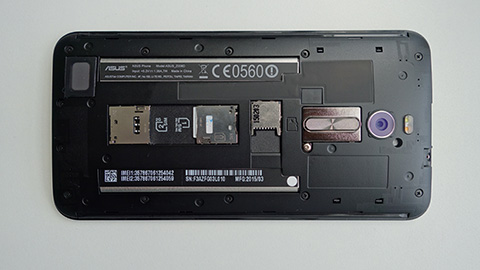We’ve gotten the first of three variants of the Zenfone 2 that will be released in the Philippines next month. This mid-range variant (ZE550ML) comes with 2GB of RAM and 16GB internal storage in a 5.5-inch 720p HD display.
This model is actually just the 3rd best in the Zenfone 2 line-up since the first 2 actually have full HD displays.

Right out of the box, there’s a 130MB system update which includes updates and bug fixes (graphics driver, LTE network, APN, etc).
The Zenfone 2’s new design is reminiscent of the HTC One M8 and the LG G3, although it’s leaning more towards the G3 with its polycarbonate body, curved back panel and the rear volume keys just below the camera.

With a 5.5-inch display, the ZE550ML looks huge but still feels comfortable in the hands. It’s bigger than the G3 even though they have the same display size. The bezels are also quite thick at 3.3mm, despite Asus’ claims that it’s already narrow.
Based on our side-by-side observation the bezels are as thick (or slightly thicker) than the side bezels of the HTC One M8 and close to 3 times as thick as the 1.15mm bezel of the LG G3. The Android capacitive buttons are still there at the bottom end (Back, Home, Recent Apps) which should have been already replaced by one-screen buttons due to Kitkat/Lollipop UI implementation.

Build quality is really good, feels solid on the hands with a comfortable grip thanks to that curved back; not too heavy or bulky either. The back cover is removable to expose access to the two micro-SIM card slots and a microSD card slot. The first SIM card slot supports up to 4G networks while the second SIM card slot only supports 2G networks.

The battery is visible but cannot be readily removed due to the card slots blocking the battery. The only way to remove is by loosening the screws around the back.
The power button is found at the top together with the 3.5mm audio port. The volume keys are at the back, just below the rear camera and dual-LED flash. The back cover has a smooth matte finish which can be prone to smudges with sweaty or oily fingers.

The 5.5-inch IPS LCD display looks pretty good and surprisingly crisp and clear even with just an HD resolution. It’s quite hard to distinguish the difference in resolution even if you place it side-by-side other full HD smartphones.

The Asus ZenUI looks simple yet really clean and nice with very little footprint so it feels light and almost bloatware-free. The pre-installed Zenlink collection includes PC Link, Remote Link, Share Link and Party Link. Of the 16GB storage, only 11.31GB is usable.

The speakers at the back sounded good, has decent volume range but did not have bass in it. The earphones that came with it are good too.
Running an Intel Atom Z3560 quad-core processor paired with 2GB of RAM worked well with Android 5.0 Lollipop. Navigation and transitions is smooth and snappy. Apps and games run just fine and multitab browsing on Chrome is effortless.

Here are the test results of the benchmarks we ran on the unit:
Antutu Benchmark: 41,968
Quadrant Standard: 18,979
Vellamo Mobile Benchmark:2,985 (Chrome), 1,357 (Multicore), 1,194 (Metal)
Nenamark 2: 59.7fps
PCMark (Ice Storm Unlimited): 8,594
After running a number of resource-intensive applications, the devices get a bit warm but nothing alarming of sorts. So far, even running 3DMark Ice Storm Unlimited only cause slight warming of the middle section of the back side.
Here are some sample photos we took as well:
The limited sample photos above show really good quality of the rear camera.
As for battery life, we managed around 8.5 to 9 hours on a full charge using our standard battery bench at 50% brightness and 0% volume.
Here’s the complete specs of this variant that we’re using for this review (we also have the ZE500CL variant that we are working on right now).
ASUS Zenfone 2 (ZE550ML) specs:
5.5-inch HD IPS display, 720×1280 pixels @ 267ppi
Corning Gorilla Glass 3
Intel Atom Z3560 1.8GHz 64-bit quad-core processor
PowerVR G6430 GPU
2GB LPDDR3 RAM
16GB internal storage
up to 64GB via microSD
13 megapixel Pixel Master camera w/ LED flash
5 megapixel front camera
Dual-SIM
4G LTE, 3G HSPA+
WiFi 802.11 a/b/g/n
Bluetooth 4.0
GPS with aGPS support, GLONASS
Android 5.0 Lollipop w/ ZenUI
Li-Ion 3,000mAh battery
This review unit was sourced from Widget City. It is available in their online store for Php9,490 (see listing here).
The post Asus Zenfone 2 (ZE550ML) unboxed, first impressions appeared first on YugaTech | Philippines, Tech News & Reviews.







